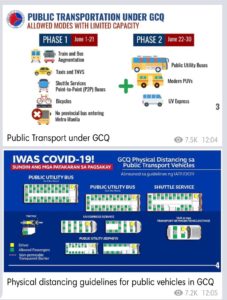 The operation of public road transportation under general community quarantine (GCQ) will be implemented in two phases, according to the Department of Transportation (DOTr).
The operation of public road transportation under general community quarantine (GCQ) will be implemented in two phases, according to the Department of Transportation (DOTr).
For phase 1, or from June 1 to 21, bus augmentation, taxis, transport network vehicle systems, shuttle services, Point-to-Point buses, and bicycles may operate, with limited passenger capacity.
Tricycles will be allowed, subject to prior approval of the concerned local government unit. No provincial buses may enter Metro Manila during this phase.
For phase 2 covering June 22 to 30, public utility buses (PUBs), modern public utility vehicles (PUV), and UV express vans may operate, also with limited passenger capacity, along with the initial set of transport modes allowed to operate during phase 1.
Metro Manila, Regions II, III, IV-A (Calabarzon), and the provinces of Pangasinan, Albay, and Davao will transition to GCQ and the remaining areas in the country to modified GCQ (MGCQ) from June 1-15.
To effectively ensure the limited capacity and passenger load of all the public transport vehicles, the one-meter social distance rule between persons will be strictly enforced inside all the PUVs and mass transport units, in adherence to health protocols.
For public transportation in areas under GCQ, stringent sanitary measures have been set, and will be strictly enforced, such as:
- wearing of face masks at all times
- implementation of no-contact measures such as cashless payments.
- use of thermal scanners
- availability of alcohol and sanitizers in PUVs
- disinfection of high-touch surfaces of vehicles
- establishment of disinfection facilities in various public transport terminals
- contact tracing
Rail sector
On the rail side, Transportation Secretary Arthur Tugade said Metro Manila’s rail systems—Light Rail Transits (LRT) 1 and 2, Metro Rail Transit 3 (MRT-3), and Philippine National Railway (PNR)—are ready to operate come June 1 with social distancing markers already in place in the railway vehicles and train stations. He noted, however, that the public should not expect 100% operations as DOTr balances its mandate to provide transportation while doing its responsibility to prevent the spread of the coronavirus disease (COVID-19).
Tugade said LRT 1 and 2’s capacity will initially only be 10% to 20%, respectively, and PNR, 35%.
MRT-3 is expected to increase its speed to 60 kilometers per hour (kph) by December from the current 30 kph as the replacement of rails will be completed by September.
DOTr said it also plans to harness “the advantages of technology in implementing its initiatives for road-based transport, to minimize physical contact or face-to-face interaction to prevent the spread of COVID-19.”
The modernization initiatives include the automatic fare collection system (AFCS) for cashless payment transactions, electronic toll collection, and GNSS/GPS.
DOTr will likewise pursue online transactions in licensing, registration and other documentary requirements.
A key digital initiative developed by the Land Transportation Franchising and Regulatory Board (LTFRB) that will be adopted is the Public Transport Online Processing System (PTOPS), which is set to run in the National Capital Region on June 1.
PTOPS will allow transactions to be made online, except the publication and hearing of cases—which will make LTFRB services faster and accessible for all its stakeholders.
DOTr said there will also be institutional changes to be implemented as the country transitions to the “new normal.”
These are as follows:
- routes rationalization for traffic management;
- industry consolidation, to make it more efficient and financially tenable for stakeholders;
- the use of shuttle services to prevent students and employees from contracting the virus, will also be encouraged;
- promotion of the use of non-motorized transport or use of bicycles, to maintain physical distancing, provide environmental and health benefits and promote efficient road space use.
In a GCQ setting, DOTr is also set to adopt a system in EDSA where dedicated lanes will be set for buses. In addition, the transformation of EDSA will include designated lanes for bicycles, as well as the putting up of pedestrian crossing and bus boarding areas in strategic places.
In areas under GCQ, road, rail, maritime, and aviation sectors for public transportation should operate at a reduced operational and vehicle capacity in accordance with guidelines by DOTr and in compliance with social distancing requirements.
In areas under MGCQ, public transportation should operate at a capacity in accordance with guidelines by DOTr and again in compliance with social distancing requirements.






Kailan po ba pwedeng mag operate ang mga provincial bus going to cagayan valley ? Need ko na po umuwi kasi sa amin. Kindly answer po para naman po alam ko. Thanks.
FYI, PortCalls is not affiliated with any government agency. Wala pa pong advise ang gobyerno kung kailan puwedeng mag biyahe ang mga provincial buses.
Hello po. Ask ko lang po kung pwedeng mag-angkas ang e-bike (3 wheels) ng isa? at same neighborhood na po kami.. Under MGCQ na rin po. Thank you.
That really depends on the local government within your area. Suggest you ask your barangay officials. The implementation of quarantine rules usually varies from area to area.
My public byahe parin po bah with in region 11 Lang hindi na lalagpas at pwede rin po bang bumalik pag mag gcq napo
Depende po iyan kung may bus services sa lugar ninyo. Paki check na lang sa mga bus companies.
Im here po in pasig.. tanong ko lang po kung pwede na bumyahe papuntang baliwag balucan or kung meron ng bus papunta dun? Thank u po in advance
Ang alam po namin wala pang mga buses servicing outside Metro Manila.Bawal din po ang non-essential travel.
May biyahe na po ba papuntang cubao galing caloocan North , and cubao papuntang cogeo tanay Rizal? Salamat po.
Kindly check from this article:
https://newsinfo.inquirer.net/1326518/ltfrb-allows-1333-jeeps-to-resume-23-routes
Please note PortCalls is a newspaper for the cargo transport industry so we don’t carry detailed stories on public transportation. Thanks.
Comments are closed.